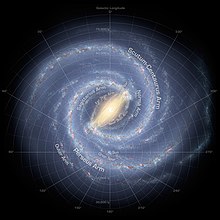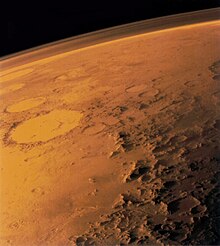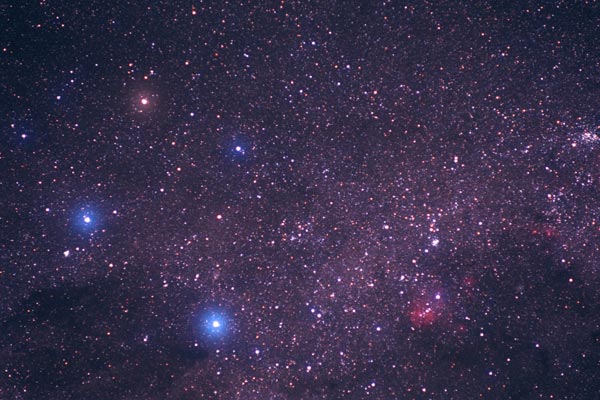 The star Epsilon Aurigae dims every 27 years due to a mysterious dark object eclipsing it periodically.
The star Epsilon Aurigae dims every 27 years due to a mysterious dark object eclipsing it periodically.  The 'Great Red Spot' - a storm on Jupiter that has been going on for 300 years - is so big that dozens of Earths would fit into it.
The 'Great Red Spot' - a storm on Jupiter that has been going on for 300 years - is so big that dozens of Earths would fit into it.
Galaxy, which moves within The Local Group of Galaxies, which moves towards Virgo Cluster.
The temperature on Mercury varies so extremely that it will rise up to 430C during the day and drop as low as -140C at night.
 The largest known star Canis Majoris is so big that if our Sun were a ball 117cm (46in) wide, Canis Majoris would be 2.25 kilometers (1.3 miles) wide.
The largest known star Canis Majoris is so big that if our Sun were a ball 117cm (46in) wide, Canis Majoris would be 2.25 kilometers (1.3 miles) wide. Despite being closest to the sun, Mercury is not the hottest planet. The hottest planet is Venus (at 462 Celsius).
 The Pistol Star
is the most luminous star known - 10 million times the power of the Sun
and as big as the size of Earth's entire orbit around the Sun.
The Pistol Star
is the most luminous star known - 10 million times the power of the Sun
and as big as the size of Earth's entire orbit around the Sun.
Earth is the only planet not named after a Roman or Greek god.
 Saturn's moon Titan has hundreds of times more oil and natural gas than all the known reserves on Earth.
Saturn's moon Titan has hundreds of times more oil and natural gas than all the known reserves on Earth.
Interstellar space is not complete vacuum: there are a few hydrogen atoms per cubic centimeter.
If a pinhead-size piece of the Sun were placed on Earth, one would have to stand as far as 145 kilometers (90 miles) away to be safe.
Made up of billions of pieces of ice, the average thickness of each of Saturn's seven giant rings only ranges from about 200 to 3000 meters.
The full Moon always rises at sunset and sets at sunrise.
About 1000 Earths would fit inside Jupiter - and the Sun could hold about 1000 Jupiters.
The speed of light - 299 million meters a second - would still take about 26 billion years to reach one end of the visible universe to the other.
The sky is blue because when sunlight collides with our
atmosphere, colours of the shortest wavelengths (violet and blue) are
scattered - and our eyes are more sensitive to see blue.
One of Jupiter's moons is believed to grow and shrink because of the water beneath its frozen surface.
The number of neuron cells in our brain is more than the total number of stars in our galaxy.
The planet Venus has the longest day.
The Earth is the densest planet in the solar system.
The Moon orbits the Earth every 27.32 days
Every second, the Sun pumps more than a million tons of material into the space through the solar wind (electrically charged particles.)
 Since Neptune's discovery in 1846, it has made just about three-quarters of one revolution around the Sun.
Since Neptune's discovery in 1846, it has made just about three-quarters of one revolution around the Sun.  Uranus is tipped on its side so that one pole is pointed at the Sun, so its poles are warmer than its equator.
Uranus is tipped on its side so that one pole is pointed at the Sun, so its poles are warmer than its equator. A cosmic year is the amount of time it takes the Sun to revolve around the center of the Milky Way, about 225 million years.
A day on the planet Mercury is twice as long as its year. Mercury rotates very slowly but revolves around the Sun in slightly less than 88 days.
 The star Alpha Herculis is so big that 25 of our entire solar system would have to be placed end to end to equal the star's diameter.
The star Alpha Herculis is so big that 25 of our entire solar system would have to be placed end to end to equal the star's diameter.
The star Sirius B is so dense, a handful of it weighs about 454,000 kgs (1 million pounds.)
The Sun contains over 99.8 percent of the total material (mass) in our solar system, while Jupiter contains most of the rest.
The Sun is 330,330 times larger than Earth.
The Sun is about 149 million kms (93 million miles) from Earth, yet it's 270,000 times closer than the next nearest star, which is 4.3 light years away.
A neutron star is the strongest magnet in the universe.
A new star is born in our galaxy every 18 days.
If a pulsar's (small star made up of densely packed neutrons) piece the size of a small coin landed on Earth, it would weigh approximately 100 million tons.
A day on Mercury, from sunrise to sunset, lasts about six Earth months.
A space vehicle must move at a rate of at least 27.35km (17 miles) per second to escape Earth's gravity.
The Sun loses 360 million tonnes of material each day.
The Earth-Moon size ratio is the largest in our solar system, excepting Pluto-Charon.
The Sun travels at a speed of 250km (155 miles) per second, but it still takes 230 million years for it to complete a single revolution of the galaxy.
Olympus Mons on Mars is the largest volcano in our solar system, almost three times taller than Mount Everest on Earth.
Jupiter's core is non-metal, but due to the immense pressure inside Jupiter, the core has become a metal.
This metal is liquid metallic hydrogen.
The cosmos contains approximately 50,000,000,000 galaxies.
Sound travels about 4 times faster in water than in air.
A large sunspot can last for about a week.
The Earth orbits the sun at an average speed of 107,220 kms per hour.
There is a high and low tide because of our moon and the Sun.
The moon is one million times drier than the Gobi Desert.
The moon is 27% the size of the Earth.
The Earth weighs 6.6 sextillion tons, or 5.97 x 1024 kg.
Sunlight takes about 8 minutes & 20 seconds to reach the Earth at 186,282 miles/sec (299,792 Km/sec).
An Astronaut can be up to 2 inches taller returning from space. The cartilage disks in the spine expand in the absence of gravity.
 The Sun is growing: In 5 billion years it will be 250 times bigger and close enough to swallow up the Earth.
The Sun is growing: In 5 billion years it will be 250 times bigger and close enough to swallow up the Earth.  Proxima Centauri is the nearest star to us after the Sun.
Proxima Centauri is the nearest star to us after the Sun.  Everything moves: Planets move within the Solar System, which moves within Milky Way
Everything moves: Planets move within the Solar System, which moves within Milky Way  Venus and Uranus are the only planets that rotate clockwise (retrograde rotation.)
Venus and Uranus are the only planets that rotate clockwise (retrograde rotation.)  All 27 of Uranus moons are named after William Shakespeare and Alexander Pope characters.
All 27 of Uranus moons are named after William Shakespeare and Alexander Pope characters.  With 63 moons, Jupiter has the largest number of moons.
With 63 moons, Jupiter has the largest number of moons.  Mars is red because its soil is very rusty (iron oxide.)
Mars is red because its soil is very rusty (iron oxide.)  Crux is the smallest of modern constellations, with only 4 bright stars.
Crux is the smallest of modern constellations, with only 4 bright stars.  The largest of modern constellations is Hydra.
The largest of modern constellations is Hydra.  The planet Venus does not tilt as it goes around the Sun, so consequently, it has no seasons.
The planet Venus does not tilt as it goes around the Sun, so consequently, it has no seasons.
No comments:
Post a Comment